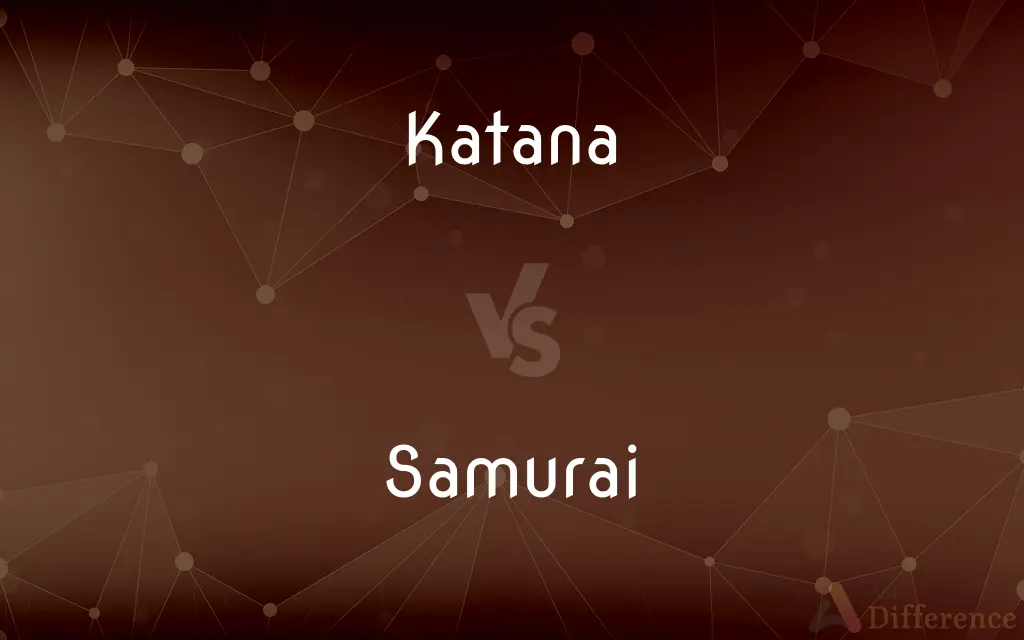Katana vs. Samurai — What's the Difference?
Edited by Tayyaba Rehman — By Fiza Rafique — Updated on September 27, 2023
Katana is a Japanese longsword, while Samurai is a member of a powerful warrior class in Japan.

Difference Between Katana and Samurai
Table of Contents
ADVERTISEMENT
Key Differences
Katana and Samurai hail from Japanese history, culture, and lexicon, representing a weapon and a class of warriors, respectively. While the Katana is a slender, single-edged blade with a circular or squared guard, the Samurai are individuals who might have wielded such a blade.
The historical significance of the Katana is not just in its design but its symbolism in Japanese society. Crafted meticulously, it became the weapon of choice for Samurai, underlining the union between the sword and the warrior. On the other hand, Samurai were not merely defined by their skill with the Katana but also by their code, known as Bushido.
Katanas, when examined in detail, have a distinct curvature, a feature developed over centuries for quick unsheathing and efficient cutting. Samurai, however, were multifaceted, being scholars, artists, and warriors, exemplifying a blend of physical prowess and cultural refinement.
The legacy of the Katana is evident today in various martial arts that teach its use, highlighting its sustained influence. Samurai, as a societal class, may no longer exist, but their ethos and stories continue to permeate Japanese culture, art, and literature.
In modern contexts, while the Katana is often seen as an item of interest for collectors and enthusiasts, the Samurai have taken on a somewhat mythic quality, often depicted in films, TV shows, and books.
ADVERTISEMENT
Comparison Chart
Definition
A type of Japanese sword
A member of a warrior class in Japan
Historical Role
Weapon of choice
Elite warrior and societal class
Cultural Representation
Symbol of martial skill
Embodiment of Bushido (warrior code)
Current Relevance
Martial arts, collectibles
Depictions in media, cultural reverence
Nature
Inanimate object
Human class
Compare with Definitions
Katana
A weapon often associated with samurai warriors.
He practiced his moves with the Katana, feeling its weight and balance.
Samurai
An individual who followed the Bushido code of ethics.
Integrity and honor were central tenets for the Samurai.
Katana
A symbol of honor in Japanese culture.
To him, the Katana was more than a weapon; it was his family's honor.
Samurai
A symbol of discipline, courage, and honor in Japanese history.
Many tales speak of the legendary deeds of the Samurai.
Katana
A blade used in various martial arts practices.
She trained with the Katana, mastering its intricate techniques.
Samurai
A member of a feudal Japanese warrior class.
The Samurai stood guard, protecting the village from invaders.
Katana
An artifact collected by enthusiasts globally.
The antique Katana fetched a high price at the auction.
Samurai
A skilled martial artist, often trained with a katana.
As a Samurai, he dedicated hours each day to perfect his swordsmanship.
Katana
A Japanese sword known for its curved blade.
The Katana hung on the wall, gleaming under the lights.
Samurai
A figure frequently portrayed in media and pop culture.
The movie depicted the Samurai as both a fierce warrior and a wise mentor.
Katana
A katana (刀 or かたな) is a Japanese sword characterized by a curved, single-edged blade with a circular or squared guard and long grip to accommodate two hands. Developed later than the tachi, it was used by samurai in feudal Japan and worn with the blade facing upward.
Samurai
Samurai (侍) were the hereditary military nobility and officer caste of medieval and early-modern Japan from the late 12th century to their abolition in 1876. They were the well-paid retainers of the daimyo (the great feudal landholders).
Katana
A long, single-edge sword for use with two hands, traditionally worn by samurai.
Samurai
The Japanese feudal military aristocracy.
Katana
A type of Japanese longsword or tr=nihontō, having a single edge and slight curvature, historically used by samurai and ninja.
Samurai
A professional warrior belonging to this class.
Samurai
In feudal Japan, a soldier who served a daimyo.
Samurai
In the former feudal system of Japan, the class or a member of the class, of military retainers of the daimios, constituting the gentry or lesser nobility. They possessed power of life and death over the commoners, and wore two swords as their distinguishing mark. Their special rights and privileges were abolished with the fall of feudalism in 1871. They were referred to as "a cross between a knight and a gentleman".
Samurai
A Japanese warrior who was a member of the feudal military aristocracy
Samurai
Feudal Japanese military aristocracy
Common Curiosities
Is a Katana exclusively Japanese?
Yes, the Katana is a distinctly Japanese sword.
Were all Samurai proficient with the Katana?
While many Samurai were trained in its use, not all exclusively wielded the Katana.
Can anyone own a Katana today?
Laws vary, but in many places, with proper licensing or as an antique, one can own a Katana.
Are Katanas made of a specific type of steel?
Traditional Katanas are made using a specialized Japanese steel called "Tamahagane."
How long is a typical Katana?
Traditional Katanas usually measure around 60-80 cm in blade length.
Were Samurai only male warriors?
Primarily, yes. But there were female warriors called "Onna-bugeisha," though not as common.
Did the Samurai serve a master?
Yes, Samurai often served a lord or "Daimyo" and pledged loyalty.
Is the art of crafting Katanas still alive?
Yes, there are still master swordsmiths in Japan who craft Katanas using traditional methods.
What's the significance of the curve in a Katana?
It facilitates quicker unsheathing and efficient cutting.
Did Samurai follow a specific code?
Yes, Samurai followed the Bushido code, emphasizing values like loyalty, honor, and discipline.
Were Samurai also involved in arts and literature?
Yes, many Samurai were also poets, artists, and scholars.
Is every curved sword a Katana?
No, the Katana has specific features and a unique crafting process that distinguishes it.
Share Your Discovery

Previous Comparison
Confess vs. Profess
Next Comparison
Gear vs. EquipmentAuthor Spotlight
Written by
Fiza RafiqueFiza Rafique is a skilled content writer at AskDifference.com, where she meticulously refines and enhances written pieces. Drawing from her vast editorial expertise, Fiza ensures clarity, accuracy, and precision in every article. Passionate about language, she continually seeks to elevate the quality of content for readers worldwide.
Edited by
Tayyaba RehmanTayyaba Rehman is a distinguished writer, currently serving as a primary contributor to askdifference.com. As a researcher in semantics and etymology, Tayyaba's passion for the complexity of languages and their distinctions has found a perfect home on the platform. Tayyaba delves into the intricacies of language, distinguishing between commonly confused words and phrases, thereby providing clarity for readers worldwide.














































